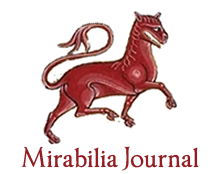Saint James in the conquest of New Spain
Carlos MORAL GARCÍA
Original title: Santiago en la conquista de Nueva España
Published in
Keywords: America, Indian-Slayer, Mexico, Moor-Slayer, New Spain, Saint James.
This paper tries to analyze the symbol of Saint James the Great in the conquest of New Spain, studing the chronicles and the different apparition of this apostle in them. Therefore, it is convenient to make an identification of the symbolic evolution of this character, from Saint James Moor-Slayer to Indian-Slayer. In addition it is paying attention to the change of this symbol and its acceptance by some American native populations, resulting in the feast of Saint James Indian-Slayer and the subsequent taking as latinamerican patron saint.
Saint Vincent Ferrer (1350-1419) and the philosophical-rethorical efficacy of sermon: Art and Philosophy
Ricardo da COSTA, Gustavo Cambraia FRANCO
Original title: São Vicente Ferrer (1350-1419) e a eficácia filosófico-retórica do sermão: Arte e Filosofia
Published in Art, Criticism and Mysticism
Keywords: Art, Medieval Rethoric, Philosophy, Saint Vincent Ferrer, Sermon.
The aim of this work is to analyze some aspects of the philosophical discourse and the medieval rethoric elements contained in the sermons of Saint Vincent Ferrer (1350-1419), especially his thoughts about a theme currently and universally present in the Christian Middle Ages: the moral virtues or cardinal virtues. For this, we will utilize a specific sermon wrote in Latin language (the Vth Sermon of the IVth Sunday of Advent), in which the preacher relates the four cardinal virtues with episodes of the life and deeds of Christ, as reported in the Gospels. The theme will be related with some artistic representations of the saint: the paintings of Joan Macip (1540-1545) and the most famous, of Alonso Cano (1601-1667), “Saint Vincent Ferrer Preaching” (1644-1645), as well as the central altarpiece of the Dominican Convent Church of Cervera (Segarra c. 1456), which represents Saint Vincent Ferrer and the Mother of God (Apocalyptic Virgin) of Pedro García de Benabarre (1445-1485). Our iconographic analysis is based on the theoretical perspective of Erwin Panofsky (1892-1968), and in the definition of image for the period according with the considerations of Jean-Claude Schmitt (1946- ).
Schemata, Motif and Topics in Theme and Variations in Sonata K305 for Piano and Violin in A Major by W. A. Mozart (1756-1791)
Aline Mendonça PEREIRA; Ernesto HARTMANN
Original title: Schemata, Motivo e Tópicas no Tema e Variações da Sonata K305 para Piano e Violino em Lá Maior de W. A. Mozart (1756-1791)
Published in Music in Antiquity, Middle Ages & Renaissance
Keywords: Compositional Procedures, Mozart’s Sonata for Piano and Violin in A Major K305, Schemata, Theme and Variations, Topics.
The present work investigates in the second movement of Mozart's Sonata for Piano and Violin in A Major K305 (1778) – Tema con Variazioni – the compositional and expressive procedures employed by the composer. To this end, it reviews the literature on the Theme with Variations (Zamacois, Stein, Schoenberg and Scliar) concepts of Topic, Style, and Schemata (Ratner, Hatten, Sutcliffe, Day-O’Connell) proposing an analysis of the movement grounded on these concepts. The results are discussed in the light of the analysis and it is concluded that, even using the non-amplifying Variation or Fantasy model; preserving formal structures due to the Schemata repeatedly employed; and presenting themselves within the script described by Ratner (from his study of contemporary treatises), the diversity of styles and topics present ensure unity of the movement as expected of a part of a larger work without abstaining the contrast that is widely explored by the vast repertoire of composer of the constitutive elements of each style.
Schemata’s interchangeability and inter-functionality of Schemata in Themes with Variations of Mozart’s Sonatas for Piano and Violin
Ernesto HARTMANN, Aline Mendonça PEREIRA, Gabriel Azevedo GUERRA
Original title: Intercambialidade e interfuncionalidade das Schemata nos Temas com Variações das Sonatas para Piano e Violino de Mozart
Published in
Keywords: Mozart, Musical Analysis, Schemata, Sonatas for Piano and Violin.
In this article we examine in Theme and Variations set of the Sonatas for Piano and Violin by W. A. Mozart (1756-1791) the relations between Schemata’s interchange, interpolation and inter-functionality. For this, we analyze the schematic composition of each movement, paying attention to the substitutions that the composer makes. In the theoretical basis we dialogue with the authors who discuss the relationship between Topic and Schemata. The work is structured as follows: conceptualization of Schemata, brief discussion about the problem of relationship between Schemata and Topic, analysis of selected works and final considerations. It is concluded that the functionality of each Schema, concept implied by Gjerdingen, is the way to understand the logic that regulates the substitutions observed in the works.
Sculpture in lower Andalusia during the eighteenth century: Interpretative summary and recent historiography
José RODA PEÑA
Original title: Escultura en la baja andalucía durante el siglo XVIII: síntesis interpretativa e historiografía reciente
Published in
Keywords: 18th Century, Baroque Sculpture, Italian import, Western Andalusia.
We approach a synthetic study of the sculpture that took place during the 18th century in Lower Andalusia, offering a series of interpretative keys, to historical, aesthetic, stylistic and iconographic level, for its better comprehension. The prolongation of the baroque forms, the introduction of the Rococo current and the transit to the tempered plastic creations of the illustrated academicism, mark the sculptural production of local and foreign artists who worked at Western Andalusia (Seville, Cadiz, Huelva and Cordova), without forgetting the import of italian works, so much relevant in Cadiz area.
Semblance of Arabic Poetry
Juan BRANDO
Original title: Semblanza de la poesía árabe
Published in The Medieval Aesthetics
Keywords: Al-Andalus, Arabism, Islamic Law, Middle Ages, Poetry.
We propose a brief approach to the Arabic Poetry of the later Middle Ages with a Reading key centered on the metaphors alluding to wine, wáter, tears, dew and flowers. Prohibition and desire, postponenment and melancholy by the absence of the beloved or exile, the pains drowned in wine, are the ways by which poetry becomes a consideration of trascendence and primordial unity.
Sensations and traditions in the discursive configuration of the miracles of liberation of Christian captives (Los Milagros de Guadalupe, 15th and 16th centuries)
Lidia Raquel MIRANDA; Gerardo Fabián RODRÍGUEZ
Original title: Sensaciones y tradiciones en la configuración discursiva de los milagros de liberación de cautivos cristianos (Los Milagros de Guadalupe, siglos XV y XVI)
Published in The World of Tradition
Keywords: Christians, Community, Guadalupe, Sensation, Tradition.
The paper analyses the miracles CXXXI, CXLVII, CLXIIIIII and CLXXXIIII of Los Milagros de Guadalupe, referring to the liberation of Christians from captivity held by the Moors during the 15th and 16th centuries. The sensory, corporal, and affective marks of the subjects of discourse, and the intertextual traces of literary traditions –that of the bestiaries, the evangelical one and that of miracles– identify the distinctive conditions of the sensory and literary community of Guadalupe that gave rise to the collection of miracles. The examination gives an account of the expressive resources used by the friars in charge of the production and propagation of the miraculous stories to establish Christian orthodoxy around the figure of the Virgin Mary of Guadalupe and the symbol and historical fleshing of the captives.
Senses and the original sin in the thinking of John Wyclif
Cecilia DEVIA
Original title: Los sentidos y el pecado original en el pensamiento de John Wyclif
Published in Senses and sensibilities in classical and medieval worlds
Keywords: John Wyclif, Middle Ages, Original Sin, Senses.
The main purpose of this article is to present an approach to the relationship between the senses and the original sin in the thinking of John Wyclif (c. 1328-1384). It will begin by making a brief outline of the link between senses and sins in the Middle Ages, to continue with a succinct exposition of the extremely versatile figure of Wyclif and its context. The first sections will be based on updated bibliography, while the last one will especially rely upon the English thinker’s Tractatus de statu innocencie, from 1376. It will be devoted to select and analyze the passages in which the author addresses the senses, both before and after the fall of Adam and Eve, and with theirs, that of all humanity.
Shouting at the Angels: Visual Experience in Angela of Foligno’s Memoriale
Pablo GARCÍA-ACOSTA
Published in Mulier aut Femina. Idealism or reality of women in the Middle Ages
Keywords: Angela of Foligno, Devotion, Franciscan Art, Memoriale, Vision..
This article is part of the scholarly revival in Angela of Foligno (c. 1248-c. 1308) studies in relation to images. With the exhibition entitled Dal visibile all’indicibile. Crocifissi ed esperienza mistica in Angela da Foligno (Foligno, October 6th, 2012 – January 6th, 2013) and the publication of the catalogue, relations between Angela’s visions and her artistic context have been examined in greater depth. However, despite the excellent essays included in the book, there is still lacking a theoretical basis to explain Angela's devotional relationship with some images and, in particular, her reception of them. The main aim of these pages is therefore to develop that theoretical background and to interpret from such a basis the events that occurred in Assisi in front of the so-called “vetrata degli angeli” (the stained glass window of the angels).
Sinfulness, Sanctity and Bodily Transgressions: Representations of Ageing, Disability and Impairment in Late-Medieval Drama
Helen Frances SMITH
Published in Pleasure in the Middle Ages
Keywords: Disability, Drama, Late-Medieval, Physiognomy, Sinfulness.
The relationship between the textual and physical representations of the disabled or impaired body and morality is an intriguing and complex area to explore in medieval literary and dramatic culture. In medieval thought, since the body and soul were seen as inextricably linked, different sins were thought to take their own physiological effects upon the body. While sexual sin, for instance, was thought to cause leprosy, the sin of avarice was thought to cause premature ageing. Yet, physical disability or impairment, and other bodily transgressions, as cultural constructs, were not always negatively received in society. Affliction could be a means of grace rather than punishment, and there is evidence that monks even prayed for physical and mental affliction to regain a state of purity. In order to explore how disability, impairment and bodily transgression is represented in the context of sinfulness and the ageing body, this paper will use a moral spectrum of characters as well as historical evidence.






















































































